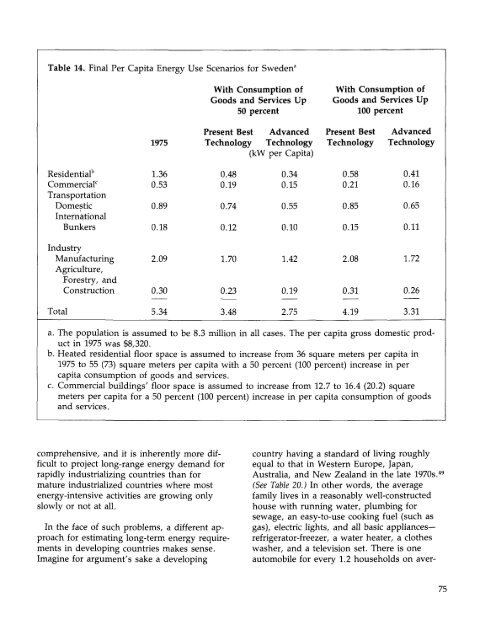ENERGY FOR A SUSTAINABLE WORLD - World Resources Institute
ENERGY FOR A SUSTAINABLE WORLD - World Resources Institute
ENERGY FOR A SUSTAINABLE WORLD - World Resources Institute
You also want an ePaper? Increase the reach of your titles
YUMPU automatically turns print PDFs into web optimized ePapers that Google loves.
Table 14. Final Per Capita Energy Use Scenarios for Sweden a<br />
With Consumption of<br />
Goods and Services Up<br />
50 percent<br />
With Consumption of<br />
Goods and Services Up<br />
100 percent<br />
1975<br />
vanced<br />
[inology<br />
Capita)<br />
Present Best<br />
Technology<br />
Advanced<br />
Technology<br />
Residential 13<br />
Commercial 0<br />
Transportation<br />
Domestic<br />
International<br />
Bunkers<br />
1.36<br />
0.53<br />
0.89<br />
0.18<br />
0.48<br />
0.19<br />
0.74<br />
0.12<br />
0.34<br />
0.15<br />
0.55<br />
0.10<br />
0.58<br />
0.21<br />
0.85<br />
0.15<br />
0.41<br />
0.16<br />
0.65<br />
0.11<br />
Industry<br />
Manufacturing<br />
Agriculture,<br />
Forestry, and<br />
Construction<br />
2.09<br />
0.30<br />
1.70<br />
0.23<br />
1.42<br />
0.19<br />
2.08<br />
0.31<br />
1.72<br />
0.26<br />
Total<br />
5.34<br />
3.48<br />
2.75<br />
4.19<br />
3.31<br />
a. The population is assumed to be 8.3 million in all cases. The per capita gross domestic product<br />
in 1975 was $8,320.<br />
b. Heated residential floor space is assumed to increase from 36 square meters per capita in<br />
1975 to 55 (73) square meters per capita with a 50 percent (100 percent) increase in per<br />
capita consumption of goods and services.<br />
c. Commercial buildings' floor space is assumed to increase from 12.7 to 16.4 (20.2) square<br />
meters per capita for a 50 percent (100 percent) increase in per capita consumption of goods<br />
and services.<br />
comprehensive, and it is inherently more difficult<br />
to project long-range energy demand for<br />
rapidly industrializing countries than for<br />
mature industrialized countries where most<br />
energy-intensive activities are growing only<br />
slowly or not at all.<br />
In the face of such problems, a different approach<br />
for estimating long-term energy requirements<br />
in developing countries makes sense.<br />
Imagine for argument's sake a developing<br />
country having a standard of living roughly<br />
equal to that in Western Europe, Japan,<br />
Australia, and New Zealand in the late 1970s. 49<br />
(See Table 20.) In other words, the average<br />
family lives in a reasonably well-constructed<br />
house with running water, plumbing for<br />
sewage, an easy-to-use cooking fuel (such as<br />
gas), electric lights, and all basic appliances—<br />
refrigerator-freezer, a water heater, a clothes<br />
washer, and a television set. There is one<br />
automobile for every 1.2 households on aver-<br />
75

















